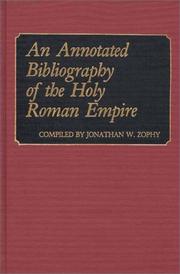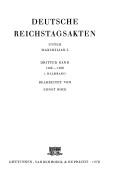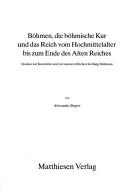| Listing 1 - 10 of 167 | << page >> |
Sort by
|

ISBN: 0313214573 9780313214578 Year: 1980 Publisher: Westport (Conn.): Greenwood,
Abstract | Keywords | Export | Availability | Bookmark
 Loading...
Loading...Choose an application
- Reference Manager
- EndNote
- RefWorks (Direct export to RefWorks)
History of Europe --- Holy Roman Empire --- History --- Dictionaries --- -History --- -Dictionaries --- Dictionaries. --- Heiliges Römisches Reich Deutscher Nation --- Heiliges Römisches Reich --- Svi︠a︡shchennai︠a︡ Rimskai︠a︡ Imperii︠a︡ --- Imperium Romano Germanicum --- S.R.I. --- Sacrum Romanum Imperium --- Austria --- Germany

ISBN: 0313240280 Year: 1986 Volume: vol 3 Publisher: New York Westport London Greenwood
Abstract | Keywords | Export | Availability | Bookmark
 Loading...
Loading...Choose an application
- Reference Manager
- EndNote
- RefWorks (Direct export to RefWorks)
Holy Roman Empire --- -History --- -Bibliography --- Heiliges Römisches Reich Deutscher Nation --- Heiliges Römisches Reich --- Svi︠a︡shchennai︠a︡ Rimskai︠a︡ Imperii︠a︡ --- Imperium Romano Germanicum --- S.R.I. --- Sacrum Romanum Imperium --- Austria --- Germany --- History --- Bibliography. --- Bibliography

ISBN: 3412105007 Year: 2001 Publisher: Köln Böhlau
Abstract | Keywords | Export | Availability | Bookmark
 Loading...
Loading...Choose an application
- Reference Manager
- EndNote
- RefWorks (Direct export to RefWorks)
Holy Roman Empire --- -Holy Roman Empire --- -History --- Heiliges Römisches Reich Deutscher Nation --- Heiliges Römisches Reich --- Svi︠a︡shchennai︠a︡ Rimskai︠a︡ Imperii︠a︡ --- Imperium Romano Germanicum --- S.R.I. --- Sacrum Romanum Imperium --- Austria --- Germany --- History
Book
ISBN: 9783775257640 3775257640 Year: 2012 Volume: 64 Publisher: Hannover: Hahn,
Abstract | Keywords | Export | Availability | Bookmark
 Loading...
Loading...Choose an application
- Reference Manager
- EndNote
- RefWorks (Direct export to RefWorks)
Carolingians --- Carolingiens --- Holy Roman Empire --- Saint Empire romain germanique --- Boundaries. --- Kings and rulers --- Frontières --- Rois et souverains --- Boundaries --- Frontières --- Carlovingians --- Carolinians --- Heiliges Römisches Reich Deutscher Nation --- Heiliges Römisches Reich --- Svi︠a︡shchennai︠a︡ Rimskai︠a︡ Imperii︠a︡ --- Imperium Romano Germanicum --- S.R.I. --- Sacrum Romanum Imperium --- Austria --- Germany --- Carolingians - Kings and rulers --- Holy Roman Empire - Boundaries --- Franconie (Allemagne) --- Histoire
Book
ISBN: 3205210913 3205787552 Year: 2012 Volume: 31 Publisher: Wien : Böhlau Verlag,
Abstract | Keywords | Export | Availability | Bookmark
 Loading...
Loading...Choose an application
- Reference Manager
- EndNote
- RefWorks (Direct export to RefWorks)
The present conference proceedings consist of 18 articles based on papers presented on 6th and 7th December 2007 at the international conference "Emperor Sigismund († 1437). Rulership in Practice, Charters and Rituals" at Masaryk-University's, Brno, Historical Institute. The conference's idea benefited from a twofold opportunity: To commemorate the anniversary of Sigismund's death on 9th December 1437 in the Moravian town of Znojmo and to conclude the international Vienna based Regesta-Imperii-project P 17519-G08 "Sigismund († 1437), Kaiser in the Reich, in Hungary and in Bohemia ", which had been funded by the Austrian Science Fund (FWF) since 2004. Sigismund, the secondborn son of ever popular emperor Charles IV. (1316-1378), came to wear not only the crown of the Holy Roman Empire but also of the Hungarian and Bohemian Kingdoms. Thus he ruled over a truly European empire that embraced partly or in total modern day's Austria, Germany, Switzerland, Italy, France, Luxembourg, the Czech Republic, Hungary, Slovakia, Rumania, Bulgaria, Slovenia, Croatia, and Serbia. This vast geographical sphere of influence spanned very different cultural, social, economic and political realities, which make it difficult to grasp the integrity of Sigismund's complex reign, but make clear its extensive European dimensions. The current volume presents the mentioned project's first outcomes. The members of the Viennese team mainly concentrate on diplomatics and charter-issuing practice, subjects so far neglected in the scientific research dedicated to Sigismund and his time. Therefore their papers for the most part deal with diverse aspects of Sigismund's production of charters and letters. Including methodical approaches of neighboring disciplines, they treat the question of typology of Sigismund's charters and charter-formulas as well as subjects of administrative and cultural history and communication studies. In addition the papers of the other involved international authors contribute to different aspects on the field of historical regional studies, administrative, religious, and cultural history as much as to the history of diplomacy, rituals, and art during the era of Sigismund's reign. Using instructive examples they all aim at shedding a light on the complex relations between Sigismund and his court to certain regions or social groups, or respectively on the role of written, oral, and symbolical communication and the use of ritual in practical rulership. The papers' main emphasis consists in Sigismund's relations to southwestern Germany, his rule in the Bohemian Lands and the historiographical work of Eberhard Windeck. The current volume throws a light on some aspects of Sigismund's rulership in practice, which either have not been dealt with at all by German historians so far, or at least seriously modify some of the popular ideas on Sigismund and his rule. The conference proceedings in their entirety give new impetus to scientific activity concentrating on the production of Sigismund's chancery and open new, innovative approaches to research on late medieval practice of royal rulership in general. main emphasis consists in Sigismund's relations to southwestern Germany, his rule in the Bohemian Lands and the historiographical work of Eberhard Windeck. The current volume throws a light on some aspects of Sigismund's rulership in practice, which either have not been dealt with at all by German historians so far, or at least seriously modify some of the popular ideas on Sigismund and his rule. The conference proceedings in their entirety give new impetus to scientific activity concentrating on the production of Sigismund's chancery and open new, innovative approaches to research on late medieval practice of royal rulership in general. main emphasis consists in Sigismund's relations to southwestern Germany, his rule in the Bohemian Lands and the historiographical work of Eberhard Windeck. The current volume throws a light on some aspects of Sigismund's rulership in practice, which either have not been dealt with at all by German historians so far, or at least seriously modify some of the popular ideas on Sigismund and his rule. The conference proceedings in their entirety give new impetus to scientific activity concentrating on the production of Sigismund's chancery and open new, innovative approaches to research on late medieval practice of royal rulership in general. s rulership in practice, which either have not been dealt with at all by German historians so far, or at least seriously modify some of the popular ideas on Sigismund and his rule. The conference proceedings in their entirety give new impetus to scientific activity concentrating on the production of Sigismund's chancery and open new, innovative approaches to research on late medieval practice of royal rulership in general. s rulership in practice, which either have not been dealt with at all by German historians so far, or at least seriously modify some of the popular ideas on Sigismund and his rule. The conference proceedings in their entirety give new impetus to scientific activity concentrating on the production of Sigismund's chancery and open new, innovative approaches to research on late medieval practice of royal rulership in general.
Regions & Countries - Europe --- History & Archaeology --- Germany --- Sigismund, --- Holy Roman Empire --- History --- Zygmunt Luksemburski, --- Siegmund, --- Sigmund, --- Zsigmond, --- Zikmund Lucemburský, --- Žigmund Luxemburský, --- Heiliges Römisches Reich Deutscher Nation --- Heiliges Römisches Reich --- Svi︠a︡shchennai︠a︡ Rimskai︠a︡ Imperii︠a︡ --- Imperium Romano Germanicum --- S.R.I. --- Sacrum Romanum Imperium --- Austria
Book
ISBN: 9783110363173 3110363178 3110391198 3110364468 Year: 2015 Volume: 82 Publisher: Berlin ; Boston De Gruyter
Abstract | Keywords | Export | Availability | Bookmark
 Loading...
Loading...Choose an application
- Reference Manager
- EndNote
- RefWorks (Direct export to RefWorks)
This study explores German literary figures' reflections on the empire from the Enlightenment to the Romantic era. It helps shed light on a central theme often overlooked in the gaps between disciplines. The Holy Roman Empire never became a quantité négligeable for writers like Wieland, Herder, Schiller, and Goethe, nor for Jean Paul, Eichendorff, and Kleist. Instead, it formed an important reference point for their thinking and writing. --
German literature --- German literature. --- Literature. --- History and criticism. --- 1700-1899. --- Holy Roman Empire --- Europe --- In literature. --- Young Germany --- Heiliges Römisches Reich Deutscher Nation --- Heiliges Römisches Reich --- Svi︠a︡shchennai︠a︡ Rimskai︠a︡ Imperii︠a︡ --- Imperium Romano Germanicum --- S.R.I. --- Sacrum Romanum Imperium --- Austria --- Germany --- Cultural nation. --- Goethezeit. --- Holy Roman Empire. --- Old Empire.

ISBN: 3525354010 9783525354018 3525354045 9783525354049 9783486581423 3486581422 9783486581416 3486581414 Year: 1973 Volume: 3 Publisher: Göttingen: Vandenhoeck und Ruprecht,
Abstract | Keywords | Export | Availability | Bookmark
 Loading...
Loading...Choose an application
- Reference Manager
- EndNote
- RefWorks (Direct export to RefWorks)
Holy Roman Empire. Reichstag --- History --- Sources --- Holy Roman Empire --- -History --- -Sources --- Holy Roman Empire. --- Sources. --- -Heiliges Römisches Reich Deutscher Nation --- Heiliges Römisches Reich --- Svi︠a︡shchennai︠a︡ Rimskai︠a︡ Imperii︠a︡ --- Imperium Romano Germanicum --- S.R.I. --- Sacrum Romanum Imperium --- Austria --- Germany --- Holy Roman Empire - History - Maximilian I, 1493-1519 - Sources
Book
ISBN: 0198163126 Year: 1995 Publisher: Oxford : Clarendon Press,
Abstract | Keywords | Export | Availability | Bookmark
 Loading...
Loading...Choose an application
- Reference Manager
- EndNote
- RefWorks (Direct export to RefWorks)
Church music --- Pastoral music (Sacred) --- Religious music --- Sacred vocal music --- Devotional exercises --- Liturgics --- Music --- Music in churches --- Psalmody --- 17th century --- History and criticism --- Religious aspects --- Christianity --- Ferdinand --- Holy Roman Empire --- Heiliges Römisches Reich Deutscher Nation --- Heiliges Römisches Reich --- Svi︠a︡shchennai︠a︡ Rimskai︠a︡ Imperii︠a︡ --- Imperium Romano Germanicum --- S.R.I. --- Sacrum Romanum Imperium --- Austria --- Germany --- Court and courtiers. --- 78.25
Book
ISBN: 3786814775 Year: 2004 Publisher: Husum Matthiesen
Abstract | Keywords | Export | Availability | Bookmark
 Loading...
Loading...Choose an application
- Reference Manager
- EndNote
- RefWorks (Direct export to RefWorks)
Zasius, Johann Ulrich, --- Maximilian --- Ferdinand --- Holy Roman Empire --- Politics and government. --- Zasius, Io. Ulricus --- Zasius, Jo. Ulricus --- Zasius, Ioannes Ulricus, --- Zasius, Joannes Ulricus, --- Zasius, Joannes Udalricus, --- Heiliges Römisches Reich Deutscher Nation --- Heiliges Römisches Reich --- Svi︠a︡shchennai︠a︡ Rimskai︠a︡ Imperii︠a︡ --- Imperium Romano Germanicum --- S.R.I. --- Sacrum Romanum Imperium --- Austria --- Germany --- Maximiliaan --- Maximilianus II

ISBN: 3786814759 Year: 2003 Publisher: Husum : Matthiesen,
Abstract | Keywords | Export | Availability | Bookmark
 Loading...
Loading...Choose an application
- Reference Manager
- EndNote
- RefWorks (Direct export to RefWorks)
Bohemia (Czech Republic) --- Holy Roman Empire --- Heiliges Römisches Reich Deutscher Nation --- Heiliges Römisches Reich --- Svi︠a︡shchennai︠a︡ Rimskai︠a︡ Imperii︠a︡ --- Imperium Romano Germanicum --- S.R.I. --- Sacrum Romanum Imperium --- Austria --- Germany --- Bohemia --- Bohemia (Czechoslovakia) --- Böhmen (Czech Republic) --- Čechy (Czech Republic) --- Czechy (Czech Republic) --- Foreign relations --- History. --- Politics and government.
| Listing 1 - 10 of 167 | << page >> |
Sort by
|

 Search
Search Feedback
Feedback About UniCat
About UniCat  Help
Help News
News